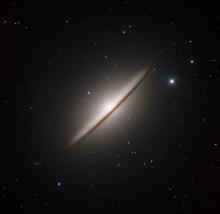Listen to today's episode of StarDate on the web the same day it airs in high-quality streaming audio without any extra ads or announcements. Choose a $8 one-month pass, or listen every day for a year for just $30.
You are here
Death of a Star
A year ago, astronomers watched the death of a star. For three months, the star blazed vividly as it was pulled apart by a black hole. At its peak, the dying star shined tens of billions of times brighter than the Sun.
The dying star was discovered on January 29th. It was seen by a network of telescopes that looks for exploding stars. Another network of telescopes quickly turned toward the event. So did two space telescopes.
By coincidence, another space telescope was already looking in that direction. TESS is a planet-hunting telescope that stares at the same patch of sky for weeks at a time. In addition to planets, it sees exploding stars and other objects that change in brightness. It first saw the dying star flare up on January 21st, although astronomers didn’t know about its observations for a few weeks.
The combination of views provided the most detailed view yet of a star being disrupted by a black hole. As the black hole pulled the star apart, a giant ribbon of hot gas was hurled into space, where it quickly cooled off. The rest of the gas eventually plunged into the black hole — never to be seen again.
The incident happened about 375 million light-years away. The black hole was about six million times the mass of the Sun — half-again the size of the black hole at the heart of the Milky Way. And the disrupted star was roughly the same mass as the Sun — an unlucky star consumed by a black hole.
Script by Damond Benningfield






